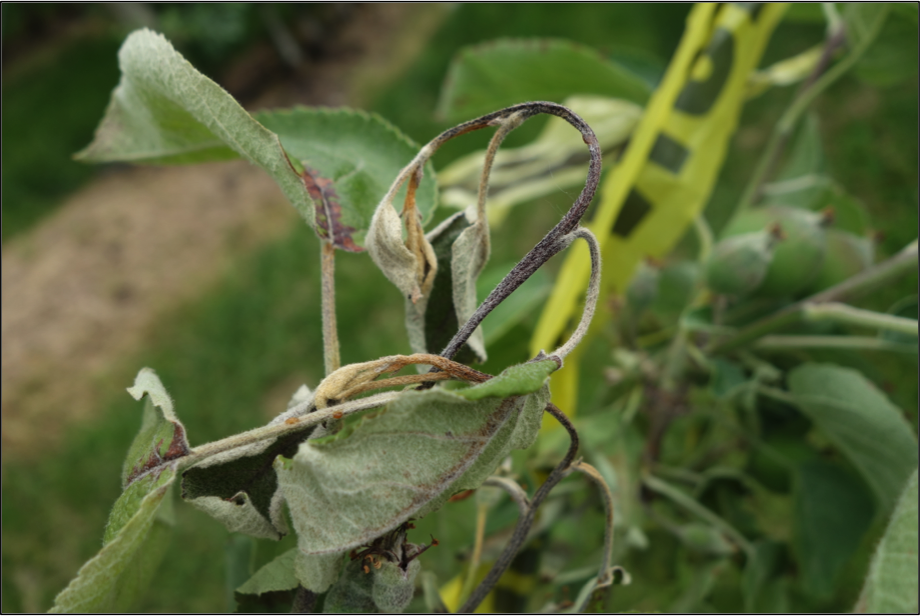
In general, lower susceptibility was observed for individuals with higher numbers of reduced-susceptibility alleles across QTLs. The highly resistant IBP ‘Enterprise’ had at least one putative reduced-susceptibility allele at all three QTLs. ‘Honeycrisp’ inherited a rare reduced-susceptibility allele at the Chr. 15 QTLs colocalized with previously reported QTLs, while the Chr. These QTLs together explained ~28% of phenotypic variation. Analyzing resistance/susceptibility data from a two-year replicated field inoculation study and previously curated genome-wide single nucleotide polymorphism data, QTLs were consistently mapped on chromosomes (Chrs.) 6, 7, and 15. Twenty-seven important breeding parents (IBPs) were represented by 314 offspring from 32 full-sib families, with ‘Honeycrisp’ being the most highly represented IBP. This study utilized a pedigree-based QTL analysis approach to elucidate the genetic basis of resistance/susceptibility to fire blight from multiple genetic sources in germplasm relevant to U.S. Most resistance alleles at quantitative trait loci (QTLs) were previously characterized in diverse Malus germplasm with poor fruit quality, which reduces breeding utility. Make one or two applications, with four days between applications.įor more information on fire blight: See UW-Extension Bulletins A1616, A3565, A2072 or contact your county Extension agent.Breeding apple cultivars with resistance offers a potential solution to fire blight, a damaging bacterial disease caused by Erwinia amylovora. Treatment with Bordeaux mixture (copper sulfate) before buds open can be effective in reducing the amount of bacteria present on branches. Avoid applying high nitrogen fertilizer, which may stimulate succulent new growth susceptible to the disease. Select a well-drained site with a soil pH of 5.5 to 6.5. How do I avoid problems with fire blight in the future? By far the most effective strategy is to choose plants with resistance to fire blight. Always, disinfect pruning tools by dipping them for at least 30 seconds in 10% bleach or alcohol after each cut (spray disinfectants that contain at least 70% alcohol can also be used). If pruning is required during the growing season, prune at least 12 inches below the diseased area. When removing diseased branches, prune six to eight inches below tissue showing visible symptoms. Prune diseased branches preferentially during the dormant season at a time when branches are dry. How do I save a plant with fire blight? There is no cure for fire blight, but its spread can be limited. They can also be spread through the plant’s water-conducting (vascular) system.

Bacteria multiply in blossoms and are carried to other plant parts where they penetrate through wounds and natural openings. The bacteria-laden ooze from the cankers is dispersed by splashing rain, and insects. Where does fire blight come from? Fire blight is caused by the bacterium Erwinia amylovora, which overwinters on the margins of cankers and starts to multiply when temperatures rise in the spring. Sapwood around cankers may discolor to a reddish brown. Current year’s twigs often wilt and bend approximately 180°, forming a “shepherd’s crook.” Cankers develop on branches and stems, and emit a sticky bacterial ooze. The blighted blossoms and leaves tend to stay on the tree instead of falling. What does fire blight look like? Blossoms, leaves, twigs, and branches of plants affected by fire blight can turn dark brown to black, giving the appearance of having been scorched in a fire.

It can kill or disfigure a tree or shrub, depending on the susceptibility of the host and weather conditions. What is fire blight? Fire blight is the most destructive bacterial disease affecting plants in the rose family, including apple, pear, crabapple, hawthorn, cotoneaster, mountain ash, quince, rose, pyracantha, and spirea. A shepherd’s crook at the end of an apple branch caused by fire blight.Īnn Joy and Brian Hudelson, UW-Madison Plant Pathology


 0 kommentar(er)
0 kommentar(er)
